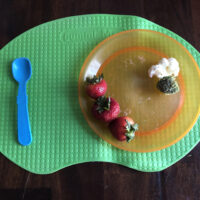A peanut allergy is downright scary and understanding the signs of an allergy is important when introducing peanut butter. When your baby is between 6-8 months old, after they have tried solid foods for the first time, they can now try peanut butter. It’s recommended not to have peanut butter as the first food your baby eats. This allows time to see if your baby has an allergic reaction to any other foods.
Things to Consider
It used to be a big no-no to give peanut butter before the age of one. However, the NIAID (National Institute of Allergy and Infectious Diseases) says waiting too long to offer peanut butter puts a child at a greater risk of developing an allergy. Here are some things to consider before offering your baby peanut butter.
Age of Your Baby
Babies can start getting solid foods when they are at least 6 months of age. At this point, they are doing a better job at sitting up on their own and have stronger neck muscles helping to keep their head up. Between the ages of 6-8 months, you can offer your baby their first taste of peanut butter, pending they have not reacted to any other foods.
You may think waiting until your child is older may help prevent a peanut allergy, but the results of one study show that children who consumed peanuts earlier in life were less likely to develop a peanut allergy by age 5.
Baby Has Started Solids
If your baby has eaten a good variety of fruits, vegetables, and meats, you are at a good point to offer peanut butter for the first time. It’s always best to offer the normally non-allergenic foods first. If your baby has had a reaction to eggs or has moderate to severe eczema, it’s best to consult a pediatrician before offering peanut butter.
Once your baby has been introduced to their first solids without a reaction, you can mix peanut butter into the fruit and vegetable purees you are giving your little one. As a reminder, only combine peanut butter with foods your baby has tolerated without a problem.
RELATED: When Can a Baby Have Strawberries
Picking the Right Peanut Butter
Staring at the shelves of peanut butter can be a bit overwhelming. Who knew there could be so many types? It’s best to go with the natural peanut butter with nothing added to them. Some brands will have specialty peanut butter with added sugar or even honey. As a note, babies under 1 should not be given honey due to the risk of botulism.
Introducing Peanut Butter to Babies
When you offer peanut butter for the first time, it’s best to give a small amount to your baby and wait 10 minutes before offering any more. This allows time for a potential allergy to show its face. If the 10 minutes go by without a reaction, then offer more peanut butter.
It’s important not to mix peanut butter with any other solids at first. You want to be able to pinpoint where a potential reaction is coming from if there is one.
Put the Peanut Butter on a Spoon
To let your little one get a taste of peanut butter, put a small amount on a spoon. It is also a good way to get your baby used to a spoon. I always thoroughly enjoyed watching my babies attempt to use a spoon when they first started eating.
It’s best only to give small amounts at a time to ensure your baby has no problem eating the peanut butter. Avoid putting large chunks of peanut butter on the spoon to prevent potential choking.
RELATED: The 20 Best Baby Spoons
Make a Peanut Butter Puree
If your little one is having a little trouble with swallowing peanut butter, try making a puree. Mix a few tablespoons of yogurt or a vegetable puree with a few teaspoons of peanut butter. If it still seems too thick, add a few teaspoons of water to thin it out.
A puree is an easy choice that requires no cooking. You can put any uneaten peanut butter puree away for another time. Put it in an airtight container and use it within 5 days.
Offer Your Baby Peanut Butter Toast
A great way for your little ones to feed themselves is by offering peanut butter toast. You can either cut the toast into bite-sized pieces or cut it into strips. It’s important not to layer on the peanut butter too thick since that can be hard for your little one to swallow.
In addition, if the peanut butter is too thick, the toast can get stuck on the roof of your baby’s mouth. One thin layer should do the trick.
FAQs – Giving Peanut Butter to Babies
How do I know if my baby is allergic to peanut butter?
I, truthfully, contemplated serving peanut butter for the first time to my oldest in the ER parking lot, just in case something happened. If you are concerned your baby could be at risk for a peanut allergy, feed it to them at their pediatrician’s office.
The following are signs of an allergic reaction:
- Swelling of the face, puffy eyes
- Redness around their mouth
- Hives
- Digestive problems
- Runny nose
More serious signs include trouble breathing, throat swelling, and swelling in and around the mouth. Most allergic reactions will happen immediately after eating peanut butter; however, there can be a delay of symptoms for a few hours. Therefore, it’s recommended not to feed your baby peanut butter within a short time frame of bedtime.
Finally, if your baby suffers from eczema or an egg allergy, they are more likely to have a peanut allergy. If your baby falls into that category, an allergist can perform a skin test to check for any evidence of a peanut allergy before offering peanut butter for the first time.
Can babies choke on peanut butter?
Peanut butter is thick, and if a baby eats too big of a serving, they could choke on it. Make sure to serve your little one thin, creamy peanut butter and avoid crunchy peanut butter. You can water down the peanut butter to thin it out even more.
Finally, it’s important not to give whole nuts to babies, as they are much more likely to choke on them. It’s recommended to wait until your child is at least 4 years old before offering whole nuts.
What’s the best way to offer peanut butter to babies?
As mentioned previously, it’s simple to offer your baby a peanut butter puree as a way to introduce the food. Adding warm water to a few teaspoons of peanut butter will help thin the consistency and make it easier for babies to swallow.
If you follow the baby-led weaning guidelines, adding peanut butter to strips of toast makes for great finger food. Just keep an eye on your little one, so they aren’t stuffing too much in their mouth at one time.
Finally, you can also add breastmilk or formula to the peanut butter before offering it to your baby. It gives them a familiar taste while enjoying peanut butter for the first time. While you likely won’t want to waste any liquid gold, you don’t need to add much. You can even hand express some breastmilk into a small bowl to mix with the peanut butter.
How much peanut butter should I give my baby?
When you are first offering peanut butter to your baby, a few teaspoons at a time is plenty. Once you’ve established that your baby doesn’t have a problem eating peanut butter, you can serve it a few times a week. In fact, the more your offer your baby peanut butter, the less likely they will develop an allergy later on.
Peanut butter should join a variety of foods you are offering your baby. Always make sure to offer a diverse grouping of vegetables, fruits, and proteins. As a reminder, up until the age of one, you should still be feeding your little one breastmilk or formula.
Final Thoughts
Most kids live off of peanut butter and jelly sandwiches. I know mine do. However, it’s imperative to fully answer the question “when can I give my baby peanut butter,” before offering the popular children’s food for the first time.
You can offer peanut butter once your baby is between 6-8 months of age and only after they’ve been introduced to other solids first without an allergic reaction. As a reminder, it’s always best to consult with your pediatrician if you have any concerns about a potential allergy.






